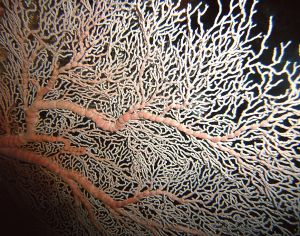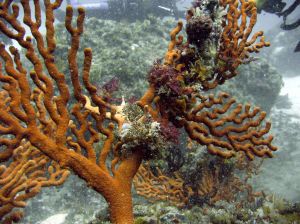Gorgonians

Gorgonians are sessile colonial animals belonging to the order Gorgonacea in the class Anthozoa. Gorgonians are known under several different names, including sea whips and sea fans. They might look like plants, but they are actually animals belonging to the same subclass as soft corals, sea anemones and sea pens/ sea pansies (Alcyonaria). There are currently about 500 described species of gorgonians.
Gorgonians can be kept in saltwater aquariums and their reputation of being virtually impossible to care for is greatly undeserved. The problem is that many sellers do not treat the gorgonians well during shipping and this makes it hard to find healthy specimens in the aquarium trade. You can read more about how to spot healthy gorgonians further down in this article. Gorgonians are not only purchased by aquarists; dried gorgonians are popular as wall decorations and some species are used as jewellery.
Gorgonians are of high interest to researchers trying to learn more about evolution since they are believed to be the first group that developed a gastrovascular cavity. Having a gastrovascular cavity means that you can take advantage of larger prey.
Anatomy and appearance
Gorgonians consist of individual tiny polyps that form colonies. Most species form colonies attached to a hard surface such as a coral reef or a rock, but some species will instead attach themselves to mud or sand.
A gorgonian colony is supported by an internal central skeleton but the exact structure of a gorgonian colony varies a lot between the various species. Many species grow erect with a flat and branched growth pattern that makes them resemble fans, but there are many species that come in other shapes and you can for instance find encrusting gorgonians, bushy gorgonians and whip-shaped gorgonians.
The order Gorgonacea is divided into two suborders: Holaxonia and Scleraxonia. In the suborder Holaxonia, the internal skeleton consists of a horny and flexible substance called gorgonin. Gorgonin is a complex protein known to contain bromine, iodine and tyrosine. In the suborder Scleraxonia, the gorgonian is instead supported by a skeleton consisting of tightly grouped calcareous spicules (i.e. needle-like skeletal parts).
Just like colony building corals the polyps of a gorgonian colony will be connected to each other by an internal layer of germs (gastrodermis) and mesoglea. This makes it possible for one part of the colony to use its caught nutrients to feed another part.
A gorgonian colony can be several feet high and several feet across without being more than a few inches thick. (1 foot = 30.5 centimetres.1 inch = 2.5 centimetres.) Some species are vividly coloured in shades of yellow, red or purple.
Geographical range, habitat and habits
Gorgonians are found throughout the oceans of the world, but the greatest profusion occurs in tropical and subtropical waters. They are primarily found in shallow waters but some species live several thousand feet below the surface (1000 feet = 305 meters). Gorgonians grow attached to a hard surface, such a rock or coral, and are common on coral reefs. Different gorgonians are found at different locations. Gorgonians that grow in shallow areas exposed to strong currents are normally highly flexible and fan-shaped, while gorgonians adapted to deeper and calmer habitats tend to be stiffer, thinner and taller.
Importance for other creatures
 |
Gorgonians are home to a wide range of marine creatures, including brittle stars, bryozoa and hydrozoa. The Pygmy seahorse (Hippocampus bargibanti) is so adapted to a life among certain species of gorgonians that it is hard to see where the gorgonian ends and the sea horse begins. Specimens that live on the gorgonian Muricella plectana are grey with red tubercles, while the specimens found on Muricella paraplectana are yellow with orange tubercles. The body of the sea horse is almost identical in appearance to the stem of the gorgonian, while the tubercles and truncated snout have the same shape and colour as the polyps.
Feeding
Just like its relative the sea anemone the gorgonian is a filter feeder. Each polyp is equipped with eight tentacles which are used to catch planktons and other types of organic matter that is brought to it by the currents. To make the process more efficient, the “fan” of the gorgonian will be oriented across the prevailing current.
Another similarity between gorgonians and sea anemones is that fact that both groups contain species that enter symbiotic relationships with algae to gain access to a more reliable food source. The algae will carry out photosynthesis and the gorgonian will therefore get energy as well as oxygen (a bi-product of photosynthesis) from the inhabitant. The upside for the algae is that is provided with a stable home in a well lit spot instead of drifting with the currents and risk being swept away to a spot where there isn’t enough light to keep it alive. Generally speaking, a gorgonian inhabited by algae will have brownish polyps while a gorgonian that relays on filter feeding will be more brightly coloured.
If you wish to keep gorgonians in your aquarium it is important to learn about their particular feeding habits. Gorgonians that contain algae will require strong lighting, while gorgonians without algae need to get all their energy from what they can filter from the water. Different aquarists advocate different food mixtures and you can for instance make your own mash from various sea foods such as shrimps, clams, squid etcetera, and/or give your gorgonians rotifers and brine shrimp.
Many gorgonians prefer to feed when the aquarium is dark and it can also be a good idea to turn off or at least turn down filters and skimmers to prevent the food particles from being filtered out of the water. Ideally start by serving a small portion of food to make the gorgonian open its polyps and serve a second larger portion when you known that the animal is ready to eat.
Gorgonians in the aquarium
Buying gorgonians
As mentioned above, it can be hard to find healthy gorgonians in the aquarium trade. Carefully examine each gorgonian before you make a purchase and do not by gorgonians from smelly aquariums. Unhealthy gorgonians tend to make the water smell bad, so this is a clear warning sign. Also avoid gorgonians with injured skin because it is really tricky to nurse such a specimen back to health. Go for gorgonians that are strong enough to keep them selves fairly upright in the aquarium and ideally purchase specimens with tick stems and large polyps. The gorgonian should have at least a small part of its original substrate left to hold on to. Even though most gorgonians are night feeders, healthy specimens will normally have some polyps open during the day.
Tank mates
Many sea creatures are interested in eating gorgonians and you must therefore choose tank mates with care and keep a watchful eye on the aquarium. Certain fire corals, polychaetes, snails, worms, and even fishes can decide to snack on the gorgonians in the aquarium.
Ideally place your gorgonian in a part of the aquarium where it can move freely with the current without touching anything but water. Placing it where it will hit corals, anemones and similar can cause injury to the gorgonian.
 |
Water movement and aeration
For a filter feed that can not hunt for food or remove its on waste products, a reliable current is naturally a must in the wild as well as in the aquarium. Continuous water movements are also necessary to keep the oxygen levels high enough. Try to mimic the habitat of the wild gorgonian by anchoring it where it will be exposed to a direct current.
Lighting
A majority of the species that are sold in the aquarium trade are shallow living gorgonians that inhabit the upper parts of coral reefs. Provide them with strong lighting, e.g. by using metal halide lights or actinic/metal halide combinations. Strong lighting is especially important for gorgonians that contain photosynthesising algae.
Filtration
The gorgonian will produce slime to remove algae, bryozoans and other malevolent organisms from it self. If the gorgonian is disturbed, the slime production can increase and prompt really powerful filtration in the aquarium. Without proper filtration, the slime can be fatal to other creatures, especially if the aquarium is small. In some cases, acute siphoning will be required.
Food
See special section about feeding gorgonians further up in this article.
Anthias
Aquarium Chillers
Basses
Batfish
Blennies
Butterflyfish
Cardinalfish
Clown fish
Corals
Damselfish
Files
Goatfish
Gobies
Gorgonians
Grammas
Groupers
Grunts
Hawkfish
Jawfish
Jellyfish
Lionfish
Dragonets
Mantis shrimp
Marine angelfish
Marine Catfish
Moray eels
Nudibranch
Octopus
Pipefish
Protein skimmers
Pufferfish
Rabbitfish
Rays
Snappers
Scorpionfish
Sea Anemones
Sea horses
Sea Stars
Shark Fish
Shrimps
Snails
Squirellfish
Surgeonfish
Triggerfish
Wrasses
